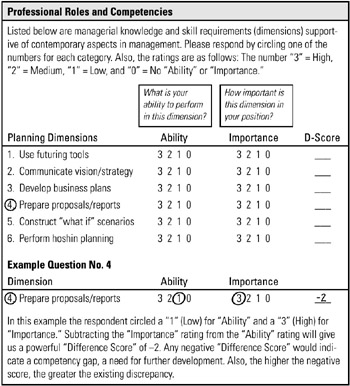Tool 37: Competency Gap Assessment
| AKA | Performance Gap Analysis |
| Classification | Analyzing/Trending (AT) |
Tool description
The competency gap assessment tool can be applied to measure organizational competencies or individual abilities to perform relative to the perceived importance of activities to be completed. Analysis of response data will directly point to individual or organizational performance gaps.
Typical application
-
To collect customer feedback data on the perceived importance of tasks versus displayed competency in the performance of tasks.
-
To check for any performance gaps between provided service and expected service.
-
To verify a possible education and training need for employees.
Problem-solving phase
| → | Select and define problem or opportunity |
| → | Identify and analyze causes or potential change |
| Develop and plan possible solutions or change | |
| Implement and evaluate solution or change | |
| → | Measure and report solution or change results |
| Recognize and reward team efforts |
Typically used by
| 1 | Research/statistics |
| Creativity/innovation | |
| Engineering | |
| Project management | |
| Manufacturing | |
| Marketing/sales | |
| Administration/documentation | |
| 4 | Servicing/support |
| 2 | Customer/quality metrics |
| 3 | Change management |
before
-
Surveying
-
Interview Technique
-
Questionnaires
-
Observation
-
Task Analysis
after
-
Needs Analysis
-
Different Point of View
-
Gap Analysis
-
Force Field Analysis (FFA)
-
SWOT analysis
Notes and key points
Competency Gap Assessment
This instrument can also be used to measure customer satisfaction simply by changing the questions and rating headings: Example:
Servicing of Generators—Various Field Sites
Please evaluate the quality of service and importance of such service to you for each category. Circle the selected number.
Service
Importance
0 = Poor
0 = To no extent
1 = Fair
1 = To some extent
2 = Good
2 = To a great extent
3 = Very Good
3 = To a very great extent
Category
Service
Importance
D-Score
1. Staff's professionalism during site visit
0 1 2 3
0 1 2 3
—
2. Equipment ready and calibrated
0 1 2 3
0 1 2 3
—
_________________________ etc. _________________________
All respondents' negative difference scores should be added to arrive at a total of negative D-Scores. The top five, ranking from highest to lowest total score, will indicate the most severe performance gaps and exactly what subject or skill dimension they represent.
Step-by-step procedure
-
STEP 1 The first step requires the identification of an important area to be measured. Candidates could be identified at the individual, group, or organizational level. See example Professional Roles and Competencies.
-
STEP 2 A set of items or dimensions that cover the critical area to be measured must be identified.
-
STEP 3 The survey rating from is developed and field tested.
-
STEP 4 After the final revisions have been made, the survey rating form is administered to targeted employees or customers.
-
STEP 5 Survey responses are "difference scored," and all negative difference scores totaled by item or dimension.
-
STEP 6 Finally, the D-Score total are ranked from high to low, as shown in the example. These performance gaps provide the input data for an action plan to close these gaps.
Example of tool application

EAN: 2147483647
Pages: 326